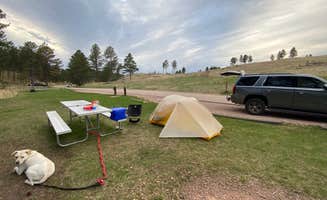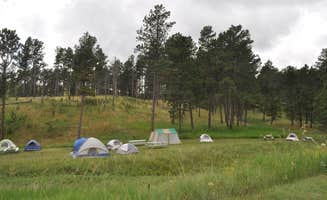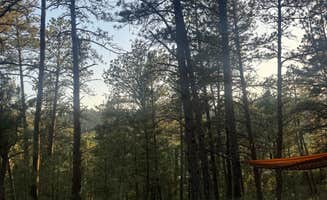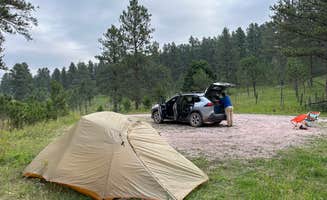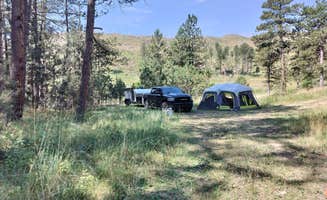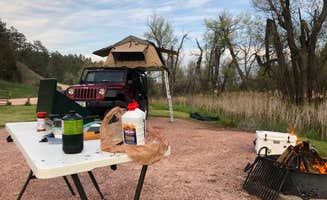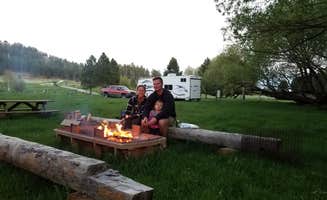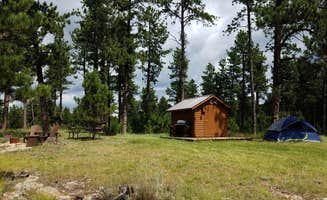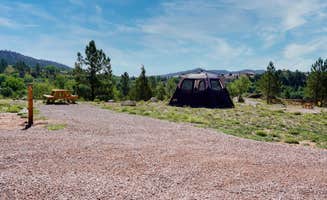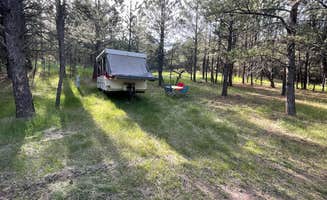Wind Cave National Park camping offers an accessible wilderness experience at 4,000 feet elevation in the southern Black Hills. The park's unique combination of mixed-grass prairie and ponderosa pine forest creates distinctive camping conditions with dramatic temperature shifts—daytime summer temperatures can reach 90°F while dropping into the 50s at night. The park's eastern border connects directly to Custer State Park, allowing campers convenient access to additional facilities.
What to do
Wildlife viewing loop drive: Take the Wildlife Loop Road in nearby Custer State Park, just 15 minutes from Elk Mountain Campground. "We saw more bison at Wind Cave than Yellowstone, Tetons, and Glacier combined," reports James W., who found the park's wildlife abundant compared to other national parks.
Cave tours with ranger guides: Reserve a guided tour of Wind Cave through the visitor center, located 1 mile from the campground. "When I visited the elevators were not operating and this limited access to the cave itself," notes Crystal C., emphasizing the importance of calling ahead to confirm tour availability.
Black Elk Peak hike: This highest point east of the Rockies offers panoramic views and can be accessed from trails near Sylvan Lake Campground. "Between the kayaking at Sylvan Lake, the resort amenities, hiking in Black Elk Wilderness, Black Elk Peak, this area is great," reports James M., highlighting the diverse recreation options.
What campers like
Secluded camping settings: Many campers appreciate the quieter atmosphere compared to busier parks. At Center Lake Campground, "Water, bluffs, pine trees... what more could you want? This place is perfect! There are great trails around the lake and along the creek. You might even catch some trout if you decide to drop a line in," shares Jennifer S.
Evening wildlife sounds: The natural soundscape enhances the camping experience. "Very quiet. Some sites have no shade at all. This one was very nicely shaded and tucked away from the road. Elk and Coyotes sounding off all night," reports Bruce K. about his Elk Mountain Campground experience.
Free dispersed camping options: For budget-conscious travelers, North Pole Road Dispersed Camping provides no-cost alternatives. "During our stay, we toured Custer State Park, Jewel and Wind Cave, as well as Mt. Rushmore. We found the location to be very central. The views are breathtaking and remarkably peaceful," notes Francois T.
What you should know
Limited connectivity: Cell service is minimal throughout the area. "T-Mobile cell service was pretty much non-existent, with no 5G signal at all, and only a sporadic 1 bar of LTE signal. I was able to make a phone call, but it kept dropping out every 10-15 seconds," reports Jacob V. from Stockade South Campground.
Seasonal water availability: Many campground water systems operate only during peak season. "Elk Mnt - Wind Cave NP 10/24 (72 yr olds in 27' trailer.) Overall Rating: 4 for stopover convenience, setting, and exploring the NP. Price 2024: $6 (the off-season, no water price) w interagency pass," explains Roger W., noting reduced prices but fewer amenities in off-season.
Site selection matters: Campgrounds have significant variation between sites. "Tent campers. Ok, if you're going to tent camp here reserve spots 7-10 and maybe 11 ish. The rest are awful for tents," advises Greebly M. about Elk Mountain, highlighting the importance of researching specific sites.
Tips for camping with families
Choose campgrounds with amenities: Families often prefer sites with more facilities. "We LOVED Blue Bell and Custer State Park! The campgrounds were very clean and quiet. Camp hosts were very knowledgeable and available if needed. Evening programs offered every night were educational and entertaining for the most part," reports Kathy M. from Blue Bell Campground.
Plan for prairie wildlife encounters: The open grasslands bring wildlife close to camping areas. "We fell in love with Custer State Park on a trip to see Mount Rushmore. We opted for a camping cabin upon arrival and were pleased with the cleanliness of the cabin and facilities. The view from our cabins poach was outstanding. The wildlife was well worth the expense compared to tent camping," shares Chad K.
Consider cabin options for unpredictable weather: The Black Hills can experience rapid weather changes, making cabins a reliable alternative. "We stayed in a rustic cabin - no water or bathroom. Only electric, heat/air. The cabin was perfect! We were able to put our hammock up between trees, there was beautiful hiking nearby with stunning views," says Jenny about her Blue Bell stay.
Tips from RVers
Check campground access limitations: Some roads and campgrounds have restrictions. "This campground has an interesting set up. The sites large enough for our 24 ft Class C were gravel pullouts along the main road and one small loop," notes a visitor about Elk Mountain, addressing size limitations.
Leveling can be challenging: The hilly terrain requires preparation. At Game Lodge Campground, "Site 34 has a very small pull out parking area. Makes me nervous with campers driving through. Site is at the bottom of a ditch. We were there after some heavy rain and no standing water and not muddy," shares Levi S., pointing out site conditions.
Electrical connections vary by campground: Not all parks offer the same hookups. "We picked Game Lodge because it had electric and I wanted to run my heater at night. It is right off the road, very open and would give no privacy if full but we were pretty much by ourselves," explains Joie V., highlighting the practical considerations for RV camping during cooler weather.


